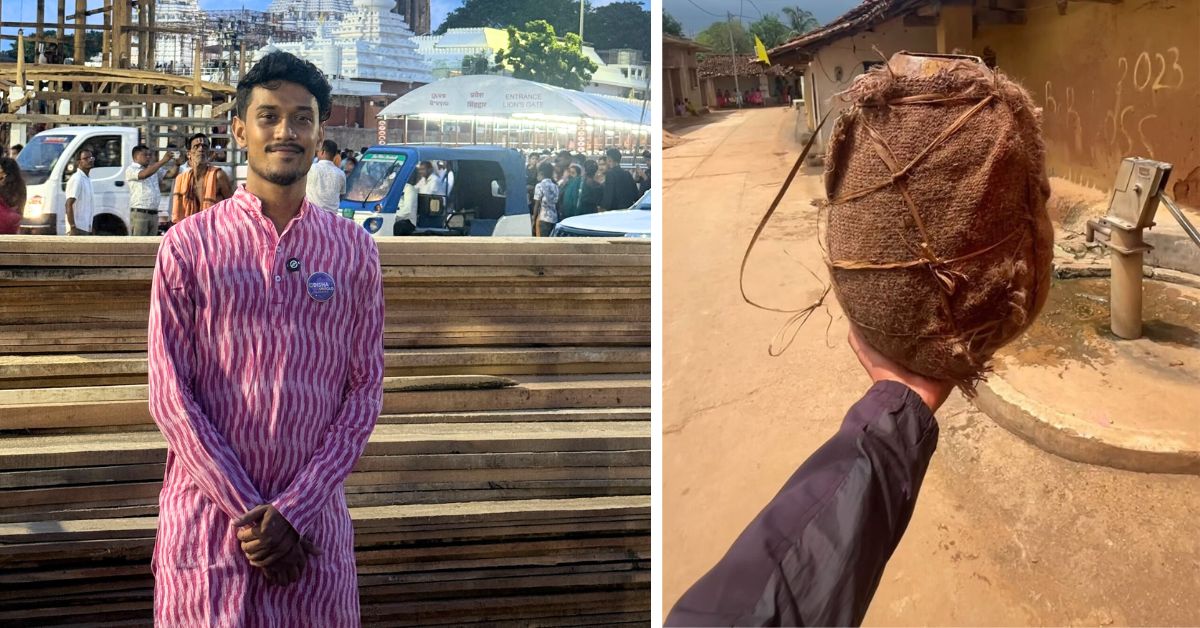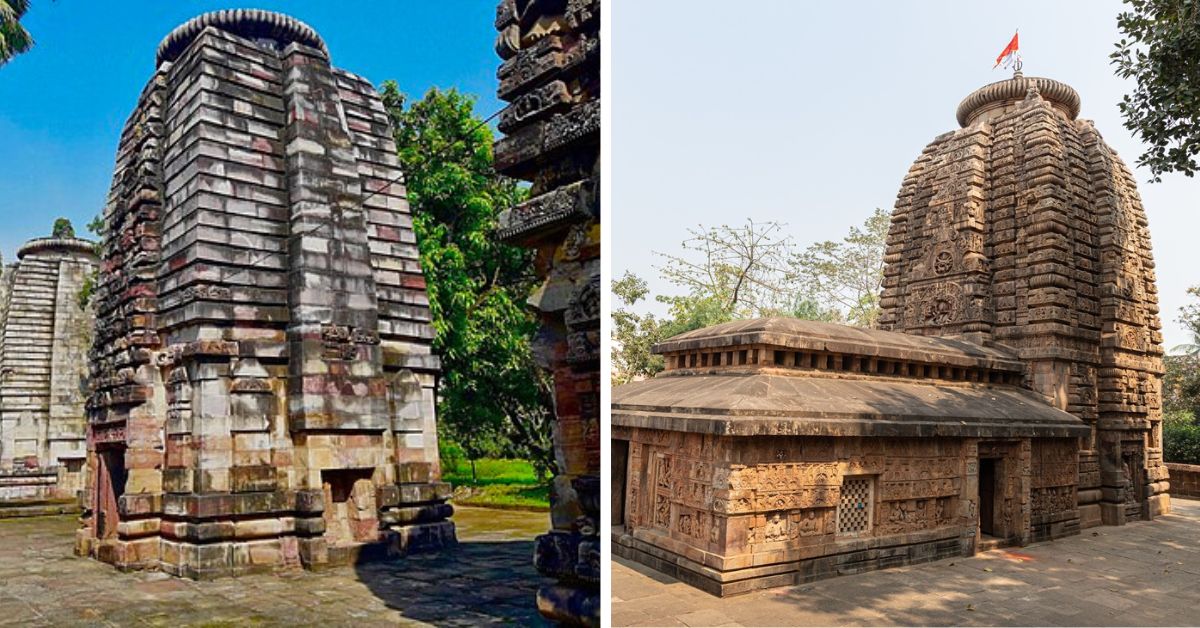Meet The Odia Creators Using Social Media & Humour to Reframe Climate Conversations
“Prakruti badaluchi (Nature is changing).”
This is the common consensus among locals in rural Odisha. Terms like ‘climate change’ and ‘global warming’ have yet to enter their everyday lexicon, as content creator Soumya Ranjan Sahoo (26) remarked during the time he spent with them, attempting to document their stories. When he asked them where they were drawing their conclusions from, they invited him for lunch.
In rural India, his hosts explained, the thali (food platter) is a canvas; it reflects the tangible impact of atmospheric shifts. While once, violets and greens and reds danced across the table — credit goes to the varied seasonal produce — now it’s just monochromes.
“The locals told me that seasonal vegetables are no longer available in the markets,” says Soumya, whose growing-up years in Sambalpur, Odisha, have given him a sound sense of local produce. “Not only are the seasons delayed, they say, but even when they do arrive, they lack their characteristics; it rains in winter, summers are unbearably hot, and monsoons often pause to make way for ‘a summer’ in between.”
In the cities, we call this global warming, a reality that the United Nations is racing against time to cap at 1.5 degrees Celsius, a threshold which, once crossed, could “unleash far more severe climate change impacts, including more frequent and severe droughts, heatwaves, and rainfall”. The people across India’s rural pockets have a bone to pick with it; the shifting seasons have heralded uncertainty into their lives. But it’s the paddy farmers who bear the brunt — rice covers 69 percent of the cultivable area; unseasonal rains incapacitate their farming patterns. “The harvest these days is less than half of what they previously achieved,” Soumya shares.
One thing is clear: despite India’s hinterland experiencing some semblance of a climate crisis, many lack the vocabulary to articulate it. And it is not their fault, says Jagadish Thaker, a senior lecturer at the University of Queensland, Australia, and principal investigator of a 2023 survey by the Yale Program on Climate Change Communication (YPCCC), which indicated that more than 90 percent of Indians are concerned about global warming.
In his opinion, “a lack of awareness doesn’t mean people are not worried about it [climate change]. It means that they don’t know that it is called global warming and that it is caused by human activities.”
But bridging this ecological literacy chasm are youth like Soumya, who are venturing into the fringes of Odisha armed with cameras and ideas. Their content is rooted in native script to help India’s hinterland verbalise the realities unfolding in the fields and on their tables.
The creators are backed by Momentum Shifts, a Bengaluru-based initiative building citizen-facing narratives for system changes, which believes in tailor-made content and humour being channelled into tackling ecological issues.
From portable refrigerators to solar-powered homes
Think of the tumba as an eco-friendly refrigerator, Soumya urges. The traditional vessel chiselled out of bottle gourd — not the usual slender ones, but imagine one comparable to the size of a man’s head — is popular among the Chuktia Bhunjia tribe in the Sunabeda Wildlife Sanctuary of Nuapada district in Odisha. The bottle gourd, harvested around once a year, is left to dry completely, then hollowed out before it doubles up as a refrigerator for transporting water. It keeps the water chilled, despite the scorching heat. Other times, the tumba acts as a seed storage.
 Soumya Ranjan Sahoo is a content creator whose content is focused on cultural innovations like the tumba (right) and their ability to tackle climate change
Soumya Ranjan Sahoo is a content creator whose content is focused on cultural innovations like the tumba (right) and their ability to tackle climate change
“This is a great innovation,” Soumya acknowledges. “But when people wonder why the tumba isn’t popular across Odisha, it’s because to make it, you need a bottle gourd of a certain size. These days, with modern farming techniques, the gourds do not grow as big.” Soumya intended for his reel to give this innovative hack a dais to shine.
Do you see what just happened?
A complex topic like heatwave, which often defies an easy interpretation, was addressed through the lens of a native innovation.
This and his other reels lie at the intersection of interactive storytelling, upbeat music — think trending rap — and compelling visuals. The aim is to create a dialogue between pressing global climate problems and people who deserve to know more.
 The tumba is a traditional vessel chiselled out of bottle gourd and is popular among the Chuktia Bhunjia tribe in the Sunabeda Wildlife Sanctuary of Nuapada district in Odisha
The tumba is a traditional vessel chiselled out of bottle gourd and is popular among the Chuktia Bhunjia tribe in the Sunabeda Wildlife Sanctuary of Nuapada district in Odisha
Soumya and the other similar content creators often get asked the typical, ‘Why not travel or food blogging? Why climate?’ question.
Well, Salman Samal (25) from Odisha’s Jagatsinghpur has lived at both ends of the spectrum. He explains, “I had started with daily vlogging. But then, I realised this wasn’t adding any value to the audience. I wanted them to follow me for informational content.”
 Salman Samal is a content creator who focuses on how solutions that locals are coming up with to tackle the effects of climate change
Salman Samal is a content creator who focuses on how solutions that locals are coming up with to tackle the effects of climate change
A story close to his heart is that of Sivanand, a resident of Bhubaneswar, who, after being stumped for a month without electricity in the aftermath of Cyclone Fani (2019), decided he needed to think on his feet. Odisha’s vulnerability to tropical cyclones meant this might not be the last of the notorious power cuts. So Sivanand devised an idea to future-proof his home against the effects of climate change — solar power. With an investment of Rs 60,000, he installed a solar panel system in his home, ensuring an uninterrupted power supply for his family. The climate-resilient solution is paying off well.
Rain or shine, Sivanand’s home is lit up.
When climate change causes cracks in history
Odisha’s Bharateswara temple was built in the sixth century. It’s said to be one of the oldest surviving temples in Odisha. But if you trace a finger around its torso, you’ll see cracks in the stone.
A study exploring the effect of environmental degradation on four such stone monuments in India’s temple town — Bharateswara temple, Vaital temple (built in the eighth century AD), Parasurameswara temple (built in 650 AD), and Mukteswara temple (dating to the 10th century AD) — emphasised cracks in the stone blocks of Bharateswara and Parasurameswara temples. Stone breakage due to thermal dilations has also been spotted in the Mukteswara shrine.
 The Bharateswara temple (L) and Parasurameswara temple (R)
The Bharateswara temple (L) and Parasurameswara temple (R)
The study held atmospheric pollutants SO2 and NOx as the major culprits. In the case of the UNESCO World Heritage Site, Konark Sun Temple, Dr Prasad Anil Kulkarni, Program Director, Department of Environmental Studies, MIT World Peace University, Pune, pointed to “increased coastal salinity and cyclonic activity” as the major risks to the temple’s structural integrity.
Salman hopes engagement will go beyond screen time and influence real-world action, so that the monuments he grew up admiring can sustain.
Having grown up in the areas whose stories they are documenting, these creators bring a well-groomed gaze to how climate change is impacting people’s lives. And their audience is loving it. The engagement their reels receive — the tumba reel drew 6,08,000 views — are proof. Momentum Shifts was confident of this strategy of elevating grassroots narratives through data-informed strategies and participatory storytelling. They’ve cracked the code.
“By bringing stories of social and environmental change to the forefront, the idea is to focus on citizen engagement, make sure people are not just informed, but feel part of the change,” shares Prachur Goel, co-founder and CEO, Momentum Shifts. He adds, “By telling powerful stories in local voices and sharing them through trusted networks, we aim to shift mindsets and build public support for long-term impact.”
While some content celebrates native ingenuity, others urge the communities to steward the currently available resources constructively. For instance, Naresh Sahu (27) from Sambalpur, told the story of the world’s smallest popcorn (locally known as bhadra), indigenous to Junapani village in Nuapada district, and commonly eaten by the Chuktiya Bhunjia tribe. The ‘popcorn’ is made from gurji, a traditional variety of millet.
Documenting such sustainable food practices is Naresh’s way of urging the locals to become environmental custodians, for climate-resilient agricultural systems — a model focused on achieving long-term higher productivity and farm incomes under climate variability.
Taking climate-positive dialogue to the remotest corners of Odisha
The tension between heatwaves and devolving mangrove conditions is a familiar story, one which is currently playing out in Bhitarkanika, one of India’s finest and largest mangrove ecosystems. A study, pointing out that the location “might see a temperature rise between 1.9 degrees Celsius and 2.1 degrees Celsius”, does not predict a happy future for the wetland. It’s estimated that by 2050, the temperatures will soar to a level that will stress the forests and associated species.
 Bhitarkanika is one of India’s finest and largest mangrove ecosystems
Bhitarkanika is one of India’s finest and largest mangrove ecosystems
“Despite the conservation efforts, the current extent of dense mangroves will decrease by 10 pc. By 2050, patches of mangrove along south-west and northern coasts of Bhitarkanika Sanctuary are projected to decrease in gross primary production and are at a higher risk of disturbance,” the report states.
The area is of special significance to content creator Bishwokesan (23), who hails from Kendrapara. He wants to mobilise people to save the mangroves. His reel outlines their benefits and encourages action-oriented dialogue.
While Bhitarkanika mangroves are its pride, the giant leatherback turtle, the largest of all living turtles, is the pride of the Nicobar Islands. Weighing up to 500 kg, it has nested along Galathea Bay for millions of years. And famed wildlife biologist and conservationist Gowri Shankar from Bengaluru scripts its importance in his reel. But in January 2021, the protected status of the sanctuary was cancelled to make way for the construction of a transhipment port.
The question remains: if the beach that these turtles call home is bulldozed, will they ever make a comeback?
Through these content pieces, the creators are democratising crucial updates around climate news.
The people of India’s villages best understand the crisis by listening to the whimpers of the land. And so, these creators are simply amplifying the land’s voice, so it can be heard loud and clear.
Edited by Khushi Arora, All pictures courtesy Momentum Shifts
Sources
Rice Farming in Odisha by Rice-based Cropping Systems Knowledge Bank, Odisha.
News